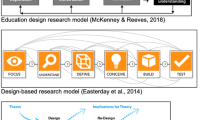Abstract
This paper describes how a novice instructional designer and his team followed the systems approach to redesign and implement a library workshop offered each year to over 4400 Freshmen enrolled in approximately 200 undergraduate English classes at a large university in the southeastern United States. The design team combined ADDIE with four instructional models: Dick, Carey, and Carey’s Systematic Instructional Design, Keller’s ARCS Motivational Design Process, Gagné’s nine events of instruction, and Bloom’s Revised Taxonomy. The redesign consisted of four phases—an instructional analysis and three phases that included elements of design, development, implementation, and evaluation. The design team was able to (a) align the workshop’s objectives with the English teacher’s expectations, (b) maintain a high-level of student motivation during the redesign, (c) improve student learning for several objectives, (d) make the instruction replicable, and (e) reduce the number of library consultations from students who had attended the workshop. The team made evidence-based decisions throughout the redesign, using formative data to make improvements. The design team felt that using multiple instructional theories simultaneously helped them execute the systematic design process by providing greater detail about each phase of ADDIE.
Similar content being viewed by others
References
Anderson, L. W., Krathwohl, D. R., Airiasian, W., Cruikshank, K. A., Mayer, R. E., & Pintrich, P. R. (2001). A taxonomy for learning, teaching and assessing: a revision of Bloom's taxonomy of educational outcomes. New York: Addison Wesley Longman.
Association of College & Research Libraries. (2016). Framework for information literacy for higher education. Retrieved from http://www.ala.org/acrl/standards/ilframework.
Botturi, L. (2006). E2ML: a visual language for the design of instruction. Educational Technology Research and Development, 54(3), 265–293.
Branch, R. M. (2009). Instructional design: the ADDIE approach. New York: Springer.
Creswell, J. W. (2009). Research design: qualitative, quantitative, and mixed methods approaches (3rd ed.). Thousand Oaks: Sage Publications.
Dick, W., Carey, J. O., & Carey, L. (2005). The systematic design of instruction (6th ed.). Boston: Pearson.
Driscoll, M. P. (1984). Paradigms for research in instructional systems. Journal of Instructional Development, 7(4), 2–5.
Gagné, R. M. (1977). The conditions of learning (3rd ed.). New York: Holt, Rinehart & Winston.
Gagné, R. M., & Briggs, L. J. (1979). Principles of instructional design (2nd ed.). New York: Holt, Rinehart & Winston.
Gustafson, K. L., & Branch, R. M. (2002). Survey of instructional development models (4th ed.). Syracuse: ERIC Clearinghouse on Information & Technology.
Gustafson, K. L., & Branch, R. M. (2007). What is instructional design? In R. A. Reiser & J. V. Dempsey (Eds.), Trends and issues in instructional design and technology (2nd ed., pp. 10–16). Upper Saddle River: Pearson Prentice Hall.
Keller, J. M. (1987). Development and use of the ARCS model of instructional design. Journal of Instructional Development, 10(3), 2–10.
Keller, J. M. (2010). Motivational design for learning and performance: the ARCS model approach. New York: Springer.
Klein, J. D., & Richey, R. C. (2015). Design and development research. In J. M. Spector (Ed.), The SAGE Encyclopedia of Educational Technology (pp. 183–184). New York: Sage.
Mager, R. F. (1975). Preparing instructional objectives. Belmont: Pitman Management and Training.
Merriam, S. B. (1988). Case study research in education: a qualitative approach. San Francisco: Jossey-Bass.
Merriam, S. B. (1998). Qualitative research and case study applications in education. San Francisco: Jossey-Bass.
Merrill, M. D. (2002). First principles of instruction. Educational Technology Research and Development, 50(3), 43–59.
Morrison, G. R., Ross, S. M., & Kemp, J. E. (2007). Designing effective instruction (5th ed.). Hoboken: Lawrence Erlbaum Associates, Publishers.
Patton, M. Q. (2002). Qualitative research and evaluation methods (3rd ed.). Thousand Oaks: Sage Publications.
Reigeluth, C. M., & Frick, T. W. (1999). Formative research: A methodology for creating and improving design theories. In C. M. Reigeluth (Ed.), Instructional design theories and models, volume II: a new paradigm of instructional theory (pp. 633–651). Mahwah: Lawrence Erlbaum Associates, Publishers.
Richey, R. C., & Klein, J. D. (2007). Design and development research: methods, strategies and issues. Mahwah: Lawrence Erlbaum.
Richey, R., Klein, J. D., & Tracey, M. W. (2011). The instructional design knowledge base: theory, research, and practice. New York: Routledge.
Rowland, G. (1992). What do instructional designers actually do? An initial investigation of expert practice. Performance Improvement Quarterly, 5(2), 30–45.
Seels, B., & Glasgow, Z. (1998). Making instructional design decisions (2nd ed.). Columbus: Merrill Publishing Company.
Shute, V. J. (2008). Focus on formative feedback. Review of Educational Research, 78(1), 153–189. https://doi.org/10.3102/0034654307313795.
Sullivan, H., & Higgins, N. (1978). Teaching for competence. New York: Teachers College Press.
Sweller, J., van Merrienboer, J. J. G., & Paas, F. G. W. C. (1998). Cognitive architecture and instructional design. Educational Psychology Review, 10(3), 251–296.
van den Akker, J. (1999). Principles and methods of development research. In J. van den Akker, R. M. Branch, K. Gustafson, N. Nieveen, & T. Plomp (Eds.), Design approaches and tools in education and training (pp. 1–14). Dordrecht: Kluwer Academic Publishers.
Visscher-Voerman, I., & Gustafson, K. L. (2004). Paradigms in the theory and practice of education and training design. Educational Technology Research & Development, 52(2), 69–89.
Wood, D., Bruner, J. S., & Ross, G. (1976). The role of tutoring in problem solving. Journal of Child Psychology and Psychiatry, 17(2), 89–100.
Author information
Authors and Affiliations
Corresponding author
Additional information
Publisher’s Note
Springer Nature remains neutral with regard to jurisdictional claims in published maps and institutional affiliations.
Rights and permissions
About this article
Cite this article
Phillips, J., Klein, J.D., Dunne, E. et al. Using Formative Data to Make Evidence-Based Decisions During Re-Design. J Form Des Learn 3, 133–145 (2019). https://doi.org/10.1007/s41686-019-00036-z
Published:
Issue Date:
DOI: https://doi.org/10.1007/s41686-019-00036-z




